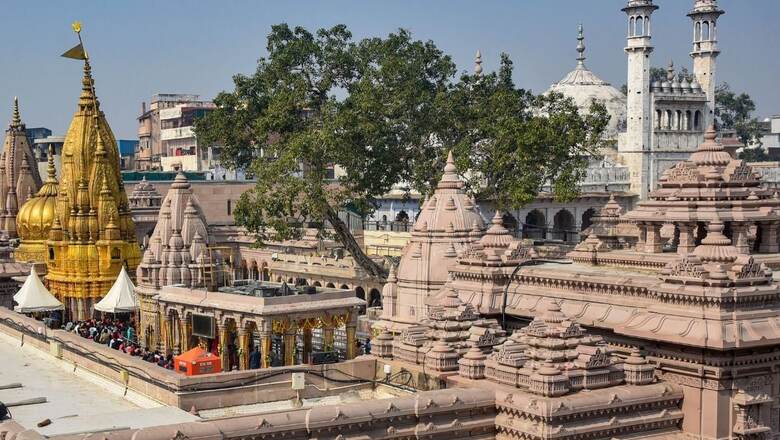
views
Recently, the pristine land of Ayodhya saw the Pran Pratishtha ceremony and the returning of Ram Lalla to the temple built at the historical site. While the event was rightfully celebrated by all, irrespective of faith and politics, it also led to many sharing the Preamble to the Indian Constitution on social media as a mark of protest to the ‘injustice’ committed on the Indian soil. The possible connotations ranged from ‘India subverting its Constitution’ to ‘a nation polarised by communalism’ against a particular section of the society. This needs to be understood that neither the Preamble nor the Constitution exists in a vacuum, the progressive values embedded in the Constitution are themselves a culmination of thousands of years old tradition of learning and re-learning. The laws and the Constitution are meant for the people and not the vice versa. The truth and reconciliation within any society should always be supreme.
The Gyanvapi Mosque-Kashi Vishwanath temple issue is another instance where we, as a society, need to move towards better sense and better communal harmony. In a pivotal development in the legal dispute over Varanasi’s Gyanvapi Masjid, a district court has granted permission for members of a family of priests to offer prayers in one of the cellars within the mosque complex. This particular cellar, known as Vyasji ka Tehkhana, was unsealed last night, and a puja ceremony took place around 3 am.
The Gyanvapi mosque, constructed in the 17th century, features four cellars, with ‘Vyas ji ka Tehkhana’ being one of them. Situated in the southern area of the mosque’s fortified complex, it stands opposite a statue of the Nandi bull within the adjacent Kashi Vishwanath temple premises. The cellar, measuring about 7 feet in height and covering an area of 40 square feet, allegedly contains idols that were worshipped before its sealing in 1993, as claimed by petitioner Shailendra Pathak Vyas. The Muslim side refuted this assertion in court, stating that the petitioner failed to provide evidence of prayers being conducted there and denying the presence of any idol in the cellar.
Following the demolition of the Babri Masjid in 1992, President’s Rule was imposed in the state, and the following year, a government led by Mulayam Singh Yadav assumed office. Citing concerns about law and order, Yadav prohibited prayers within the cellar temple. The petitioner contends that regular prayers were conducted by Somnath Vyas before the cellar was sealed.
The mosque committee has expressed its intention to challenge the court’s decision in the high court. Lawyer Akhlaq Ahmed asserted that the order overlooked the Advocate Commissioner’s 2022 report, the ASI’s report, and a 1937 decision favouring their stance. He argued that the Hindu side failed to provide evidence of prayers before 1993 and that there is no idol in the designated place.
Advocate Merajuddin Siddiqui accused district officials of colluding with the district magistrate, suggesting a political agenda. He drew parallels to the Babri Masjid case, claiming that the Commissioner’s and ASI’s reports previously confirmed the absence of any contents inside the cellar.
While it requires nothing more than a pair of eyes to establish that a temple existed at the site where the structure of the mosque today stands, there is ample architectural and textual evidence to back up this claim as well.
According to Yugeshwar Kaushal, a PhD scholar specialising in South Asian Studies, Maharaja Jayachandra erected an elaborate temple at the site following his coronation around 1170-89 AD. During Maharaja Jai Singh I’s reign, Aurangzeb, motivated by religious zealotry, demolished the Kashi Vishweshwar temple in 1669. He then constructed the present-day Gyanvapi mosque on the remains, as stated by Kaushal.
Subsequently, control of Varanasi shifted to the Nawabs of Awadh, who ensured that the disputed structure was never reconstructed as a temple. “Later, control of Varanasi passed to the Nawabs of Awadh. Saadat Khan, the then Nawab of Awadh, appointed a Raja of Benaras and ensured that the disputed structure was never reconstructed as a temple.
Subsequently, the British took control of Awadh from the Nawabs and maintained the status quo of the contested structure,” explained historian Professor (Retd) RS Khangarot.
The Varanasi court’s recent request for a “scientific investigation” by the ASI, involving ground-penetrating radar surveys and excavation, faced a temporary pause from the Supreme Court. The ASI initiated the survey in August 2023, with several extensions granted for the final report.
One needs to look no further than the texts as primary as Maasir-i-Alamgiri, a Persian-language chronicle written shortly after Aurangzeb’s death in 1707. The ASI report refers to historian Jadunath Sarkar’s 1947 translation of the text. According to the Maasir-i-Alamgiri, “His Majesty [Aurangzeb], eager to establish Islam, issued orders to the governors of all the provinces to demolish the schools and temples of the infidels, and with the utmost urgency put down the teaching and the public practice of the religion of these disbelievers.”
The royal decree issued in Aurangzeb’s twelfth regnal year on April 9, 1669, resulted in the destruction of both the Vishwanath temple in Kashi and the Keshavdev temple in Mathura. Historian Sarkar interpreted this as part of Aurangzeb’s broader “attack on Hinduism”.
SAA Rizvi noted that “Aurangzeb’s reign was marked by a gradual departure from Akbar’s policy of coexistence”. In 1665, he imposed double customs duty on imports by Hindu traders compared to Muslims, and two years later, he entirely abolished customs duty for Muslims.
“In January 1669, the wedding of Prince Azam… offered the Emperor a chance to show his orthodoxy by issuing innumerable puritanical ordinances,” Rizvi wrote. “A general order to demolish temples and Hindu centers of learning was issued. The celebrated Visvanatha Temple of Banaras and the Keshava Rai Temple of Mathura, which had been presented with a stone railing by Dara Shukoh, were reduced to ruins. This policy was implemented even in remote East Bengal, Palamau, Rajasthan, and later in the Deccan,” he added.
However, historian Richard Eaton argued that the 1669 decree was not a “general order for the immediate destruction of all temples” but rather “targeted at those institutions where a certain kind of teaching had been taking place”.
Eaton pointed to a line from the Maasir-i-Alamgiri stating that Aurangzeb had learned that in certain places, “and especially at Benares, the Brahman disbelievers used to teach their false books in their established schools, and that admirers and students, both Hindu and Muslim, used to come from great distances to these misguided men”.
Historian Satish Chandra observed that “Aurangzeb began to look upon temples as centres of spreading subversive ideas, that is, ideas which were not acceptable to the orthodox elements”.
Even historian Audrey Truschke, known for whitewashing Aurangzeb, could not completely gloss over his acts of desecrating temples. She states, “Aurangzeb brought down the bulk of Benares’ Vishvanatha Temple in 1669. The temple, constructed during Akbar’s reign by Raja Man Singh, whose great-grandson, Jai Singh, was believed by many to have assisted Shivaji in fleeing from the Mughal court in 1666.”
Chandra concurred: “In case of conflict with local elements, he (Aurangzeb) now considered it legitimate to destroy even long-standing Hindu temples as a measure of punishment and as a warning.”
As can be inferred, the temples in Benares, and elsewhere, were also centres of learning and education benefiting both Hindus and Muslims, which a religious zealot like Aurangzeb could not fathom.
The pressing need of the moment is truth and reconciliation regarding the Gyanvapi Mosque-Kashi Vishwanath Mandir complex. This historical rift requires sincere closure and healing, aiming to prevent future generations of India from enduring inter-community tensions. In this profound civilisational matter, there exists an opportunity for peace and justice-seeking Indians to address issues that have a generational impact on the collective consciousness of entire communities. One needs a comprehensive understanding of the issue, encompassing its origins, complex history, legal avenues, and potential paths forward. Let us hope the children of mother India liberate themselves from the shackles of history, reconcile their challenging past, and forge a remarkable future where they can lead the new world order.
The writer takes special interest in history, culture and geopolitics. Views expressed in the above piece are personal and solely that of the author. They do not necessarily reflect News18’s views.















Comments
0 comment